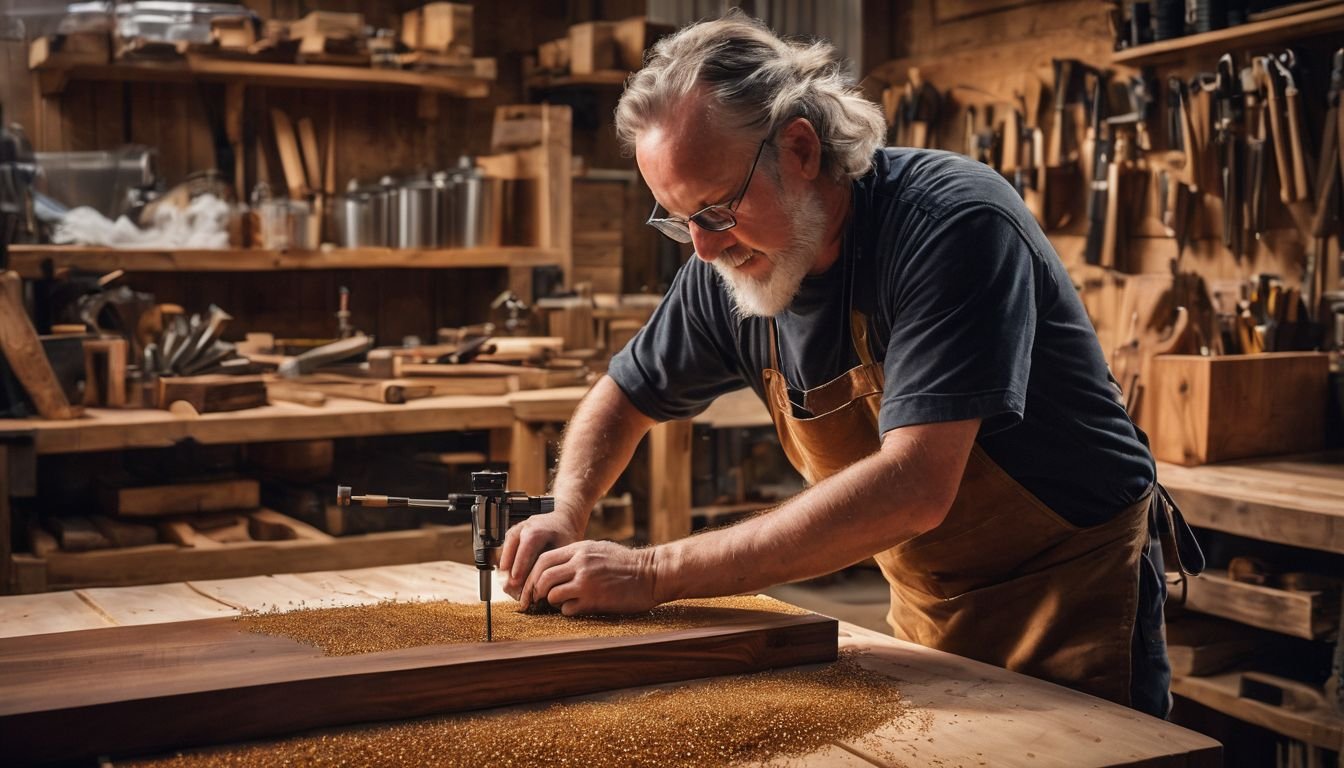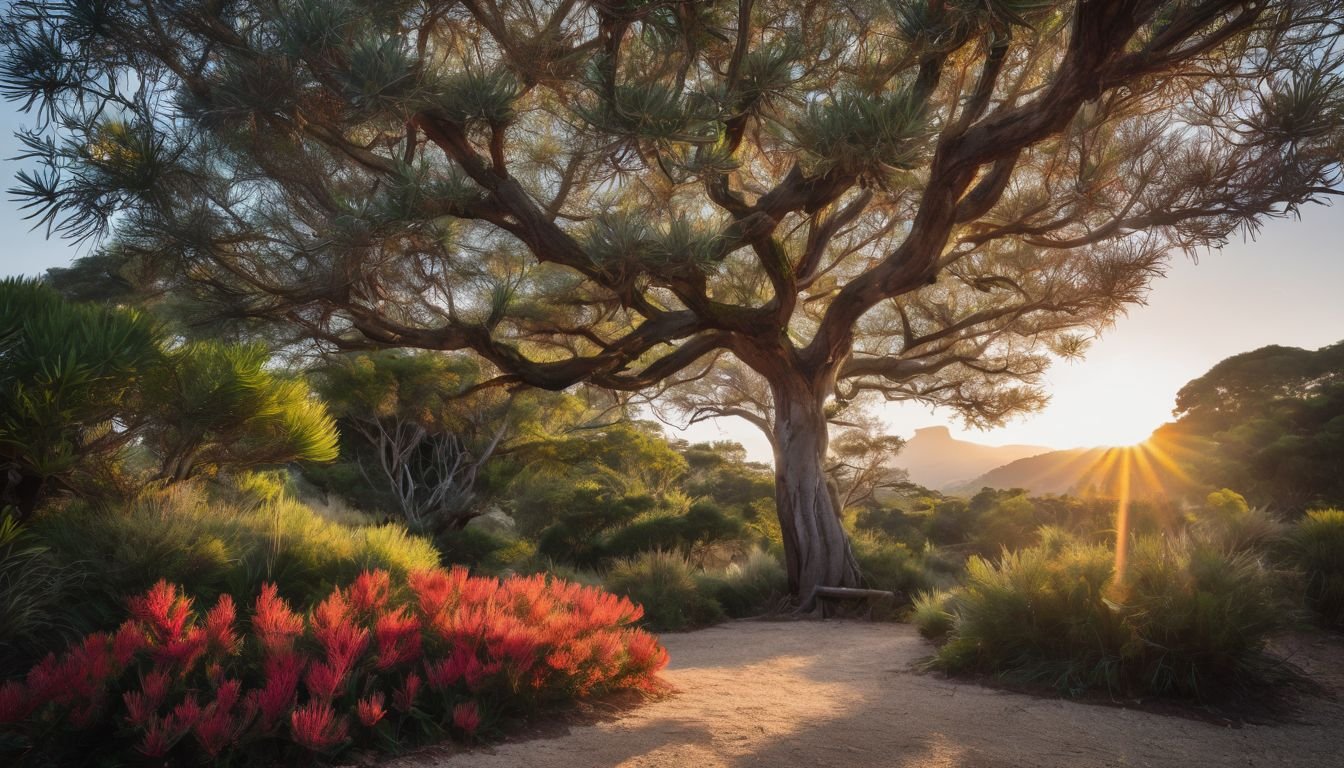Standing tall in its native Australian landscapes, the Grevillea robusta boasts an impressive silhouette that captures attention with its vigorous growth and distinctive aesthetic.
Known for its towering presence and lush foliage, this ornamental tree is a celebration of nature’s artistry, unfolding its botanical splendour through intricate leaves and vibrant blooms.
Appearance and Growth
Grevillea Robusta, commonly known as the silk oak or Australian silver oak, impresses with its majestic height and lush, fern-like foliage. Reaching up to a towering 40 metres tall with a robust single trunk, this evergreen tree commands attention in any landscape.
Its bark is a striking dark grey, deeply furrowed to add texture and depth. The leaves are not your typical green canvas; they stretch out 10-34 cm long and showcase an intricate array of lobes that can number anywhere from 11 to 31.
This ornamental tree doesn’t take its time reaching for the skies; it’s known for its rapid growth rate. Adapting well as a street tree in warm zones, grevilleas thrive under full sun and have an impressive tolerance to drought once settled in their new home.
During the flowering season from September through November, Grevillea Robusta becomes even more spectacular – adorned with golden-orange flowers that resemble toothbrush bristles arranged along one side of the stem.
These vibrant blooms don’t just captivate onlookers; they’re a hotspot for wildlife attraction too.
Unique Leaf Structure
Moving from the impressive growth rate of Grevillea Robusta, its leaves deserve special attention for their distinctive beauty. Comprising 10 to 34 centimetres in length and 9 to 15 centimetres wide, these fern-like leaves display a complex arrangement with anywhere between 11 and 31 main lobes.
The intricate leaf structure not only contributes to the tree’s ornamental charm but also demonstrates an exceptional adaptation for survival in diverse environments, from subtropical rainforests to drier regions.
With lobes spreading out like feathers from a central stem, each leaf presents a delicate yet resilient silhouette against the sky. Observers are often struck by this feature—the way sunlight filters through, casting shadows that dance on the ground below makes it clear why this species is favoured for both private gardens and public spaces.
It thrives well beyond New South Wales’ borders; whether planted as street trees in Sydney or cultivated within Australian National Botanic Gardens, it draws admiring glances year-round without asking much in return except perhaps occasional pruning to maintain shape or manage size.
Golden-Orange Flowers
Continuing from the fascinating leaf design, Grevillea Robusta doesn’t hold back when it comes to its floral display. The tree becomes a beacon of vibrancy with its golden-orange flowers that create a stunning contrast against the green foliage.
These blooms are uniquely arranged in one-sided clusters resembling toothbrush bristles, adding an exotic touch to gardens.
Each flower group bursts with rich yellowish orange or reddish hues, catching the eye and inviting a variety of wildlife to partake in their nectar. Plant lovers will appreciate these striking features that make Grevillea Robusta not only a fast-growing choice for landscaping but also an alluring spectacle during its flowering season.
Significance and Uses of Grevillea Robusta

Grevillea Robusta shines as a multipurpose tree that offers both practical and aesthetic benefits. Gardeners appreciate its ornamental value, with showy golden-orange flowers that attract nectar-loving birds and insects, bringing vibrant life to gardens.
This tall evergreen is not just about looks; it serves admirably in windbreaks or as a privacy screen, fast-growing enough to provide quick results for landscaping projects. Its resilience makes it an excellent choice for areas prone to dry spells because of its drought-tolerant nature.
Carpenters and woodworkers hold Grevillea Robusta timber in high esteem due to its versatility. The wood, commonly referred to as Silkoak because of its silky texture when cut, finds use in fine furniture making and detailed joinery work.
It’s also fashioned into guitar backs where its acoustic properties are valued. Historically significant before aluminium’s widespread use, the durable timber remains sought after today for sturdy outdoor applications such as fencing.
As we examine the environmental impact of this species beyond cultivation grounds, our attention turns towards understanding how something so beneficial can also be considered an invasive threat in certain regions.
The Invasive Nature of Grevillea Robusta
Silk-oak’s spread beyond its native Australian borders proves problematic due to its invasive characteristics. Escaped cultivation from landscaped gardens, the robust tree now disrupts native ecosystems in regions such as South Africa, New Zealand, and French Polynesia.
Its hardy nature allows it to out-compete local species for resources, often leading to a decline in biodiversity.
Efforts to control Grevillea Robusta populations highlight the challenges of managing environmental weeds. Regular pruning may limit their growth in garden settings but does little to curb their wild expansion once established.
In certain areas, this species has been officially labelled an environmental weed due to its ability to thrive and dominate in dry rainforest climates where it was not originally found.
Spotlight on Grevillea Varieties: Grevillea ‘Moonlight’
Grevillea ‘Moonlight’ shines in gardens with its striking flowers that glow like moonbeams against the silvery foliage. This beauty lures a symphony of birds and bees, turning any space into a lively sanctuary.
It stands out as a hardy selection for Australian landscapes, thriving with minimal care yet offering abundant rewards.
Adaptable to various garden roles, Grevillea ‘Moonlight’ can spread its charm as dense ground cover or stand tall as an elegant hedge. Its drought resistance is a gardener’s dream, demanding little water once it takes root firmly in well-drained soils.
Gardeners prize this hybrid offspring of Grevillea banksii and Grevillea whiteana for both its ornamental value and ease of maintenance; simply prune to shape or boost bushier growth without worry—this resilient plant will bounce back, full of life and ready to impress.
Conclusion
As we journey through the world of Grevillea Robusta, it’s clear why this tree captivates so many. With its striking flowers and lush foliage, it adds unique vibrancy to any landscape.
Plant enthusiasts will find joy in nurturing such a remarkable species, contributing to both biodiversity and beauty. Remember that while it’s an ornamental delight, responsible cultivation is key to preserving local ecosystems.
Let’s cherish these magnificent trees and ensure they continue to thrive for generations to come.
Discover the enchanting beauty of another Grevillea species by exploring Grevillea ‘Moonlight’, a stunning addition to any Australian garden.
FAQs
1. What makes Grevillea Robusta a popular ornamental tree in Australia?
Grevillea Robusta, also known as Silky Oak, is popular for its fast growth and decorative features, with compound leaves and attractive flowers that add to the beauty of gardens across Australia.
2. Can I find Grevillea Robusta outside of mainland Australia?
Yes, this ornamental tree can be found on islands like Norfolk Island and Lord Howe Island; however, it’s crucial to note that it should be managed properly to prevent it from becoming an invasive species.
3. How do I purchase a Grevillea Robusta if I’m interested in planting one?
To buy a Silky Oak, you might use various payment methods such as Visa, MasterCard, American Express or even digital options like Apple Pay and PayPal at nurseries or special herbaria which supply plants.
4. Is there anything unique about the flowers of the Silky Oak?
Certainly! The flowers of the Grevillea Robusta exhibit an intriguing structure including a long pistil amidst vibrant petals – catching attention in any garden setting.
5. Does the Grevillea Robusta shed its leaves annually like deciduous trees?
Actually no – although some may assume it’s deciduous due to its luscious foliage; Silk Oaks keep their compound leaves throughout the year – only occasionally shedding older ones.
